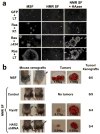High-molecular-mass hyaluronan mediates the cancer resistance of the naked mole rat
- PMID: 23783513
- PMCID: PMC3720720
- DOI: 10.1038/nature12234
High-molecular-mass hyaluronan mediates the cancer resistance of the naked mole rat
Abstract
The naked mole rat (Heterocephalus glaber) displays exceptional longevity, with a maximum lifespan exceeding 30 years. This is the longest reported lifespan for a rodent species and is especially striking considering the small body mass of the naked mole rat. In comparison, a similarly sized house mouse has a maximum lifespan of 4 years. In addition to their longevity, naked mole rats show an unusual resistance to cancer. Multi-year observations of large naked mole-rat colonies did not detect a single incidence of cancer. Here we identify a mechanism responsible for the naked mole rat's cancer resistance. We found that naked mole-rat fibroblasts secrete extremely high-molecular-mass hyaluronan (HA), which is over five times larger than human or mouse HA. This high-molecular-mass HA accumulates abundantly in naked mole-rat tissues owing to the decreased activity of HA-degrading enzymes and a unique sequence of hyaluronan synthase 2 (HAS2). Furthermore, the naked mole-rat cells are more sensitive to HA signalling, as they have a higher affinity to HA compared with mouse or human cells. Perturbation of the signalling pathways sufficient for malignant transformation of mouse fibroblasts fails to transform naked mole-rat cells. However, once high-molecular-mass HA is removed by either knocking down HAS2 or overexpressing the HA-degrading enzyme, HYAL2, naked mole-rat cells become susceptible to malignant transformation and readily form tumours in mice. We speculate that naked mole rats have evolved a higher concentration of HA in the skin to provide skin elasticity needed for life in underground tunnels. This trait may have then been co-opted to provide cancer resistance and longevity to this species.
Conflict of interest statement
Authors declare no competing financial interests.
Figures




Comment in
-
Tumour suppression: No contact please.Nat Rev Cancer. 2013 Aug;13(8):522. doi: 10.1038/nrc3568. Epub 2013 Jul 4. Nat Rev Cancer. 2013. PMID: 23822980 No abstract available.
-
Reply to: Transformation of naked mole-rat cells.Nature. 2020 Jul;583(7814):E8-E13. doi: 10.1038/s41586-020-2411-9. Nature. 2020. PMID: 32612220 Free PMC article.
-
Transformation of naked mole-rat cells.Nature. 2020 Jul;583(7814):E1-E7. doi: 10.1038/s41586-020-2410-x. Epub 2020 Jul 1. Nature. 2020. PMID: 32612221 No abstract available.
References
-
- Buffenstein R, Jarvis JU. The naked mole rat--a new record for the oldest living rodent. Sci Aging Knowledge Environ. 2002:pe7. - PubMed
-
- Buffenstein R. Negligible senescence in the longest living rodent, the naked mole-rat: insights from a successfully aging species. J Comp Physiol [B] 2008;178:439–445. - PubMed
-
- Turturro A, et al. Growth curves and survival characteristics of the animals used in the Biomarkers of Aging Program. J Gerontol A Biol Sci Med Sci. 1999;54:B492–501. - PubMed
Publication types
MeSH terms
Substances
Grants and funding
LinkOut - more resources
Full Text Sources
Other Literature Sources
Research Materials

